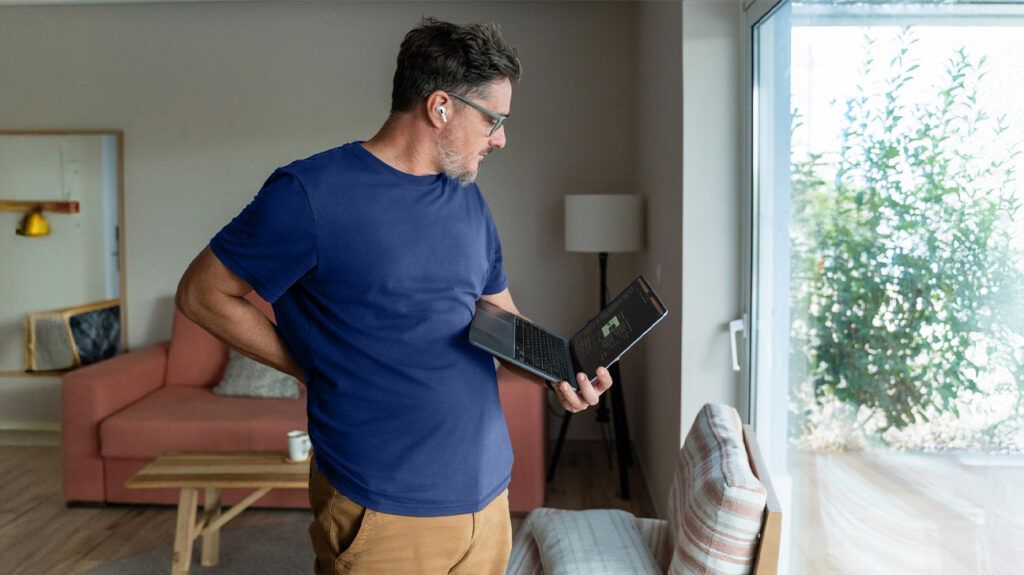Common reasons for back pain include muscle strain, disk damage, and some chronic conditions, such as fractures due to osteoporosis. Potential treatments include heat therapy, acupuncture, or medications.
There are many potential causes of back pain. Back pain may originate in the muscles, bones, or ligaments of the spine. It could also come from the spinal cord and nerves or problems with the internal organs.

Strains and sprains
Strains are injuries to muscles or tendons, while sprains affect the ligaments. Examples of movements that could lead to one of these injuries include:
- pushing, pulling, lifting, or carrying something
- bending over
- twisting the spine abruptly
- coughing or sneezing
Other types of injury that
Learn the difference between a sprain and a strain.
Posture
Posture refers to how a person holds themselves when sitting or standing. Over time, some postures
Examples of postures that may eventually cause pain include:
- forward head posture, which is when the head juts forward over the spine
- slouching, which involves sitting or standing with rounded shoulders
- hyperlordosis, which is when the hips tilt forward, arching the lower back
Everyday activities can also mean a person adopts an unhealthy posture for prolonged periods. Examples include:
- driving
- using a laptop or computer that is too low down
- sitting in chairs or on couches that do not support the back
- sleeping on an unsupportive mattress
Learn more about different types of posture.
Structural problems
Some structural problems of the spine may also result in back pain. These
- Ruptured disks: Disks cushion each vertebra in the spine. If the disk ruptures, it exerts more pressure on a nerve, resulting in back pain. Sometimes, this pain may travel through the buttock and down the back of a leg. This is known as sciatica.
- Bulging disks: Similarly, a disk that bulges from its place between the bones can put pressure on a nerve. Sometimes, this may also result in sciatica.
- Arthritis: Osteoarthritis can cause problems with the joints in the hips, lower back, and other areas of the body. Sometimes, the space around the spinal cord narrows. Health experts call this spinal stenosis.
- Osteoporosis: This causes the bones to become brittle and porous. When this leads to fractures, osteoporosis may cause back pain.
- Curvature of the spine: Back pain can occur if the spine curves too much. An example is scoliosis, in which the spine curves to the side.
Other causes
Other factors that may lead to back pain include:
- kidney stones
- menstrual cramps
- endometriosis
- pregnancy
- infections of the spine, bladder, kidneys, or reproductive system
- shingles, which lies dormant in nerves and can reactivate, causing a painful rash along the nerve path
- cauda equina syndrome
- cancer of the spine
Learn more about spinal problems.
Back pain can vary in location, severity, and the type of pain a person experiences.
For example, muscular pain may feel achy, tight, or like a spasm. Nerve pain may cause stabbing, burning, or shooting pain, while pain in the bones may feel deep and dull.
Some back issues can also cause pain in other parts of the body. For example, sciatica can also affect the legs.
Along with pain, a person with back pain may also have:
- difficulty sitting or standing
- difficulty putting weight on one or both legs
- pain when moving in certain ways but not others
- difficulty sleeping
Learn more about sciatica.
A person should seek medical help if they have back pain:
- that does not improve with rest
- after an injury or fall
- with weakness
- with tingling or “pins and needles”
- with unexplained weight loss
If any of the following occur alongside the pain, seek medical attention immediately:
- fever
- incontinence
- sudden difficulty urinating or having bowel movements
- numbness anywhere in the body
- a lump or swelling on the back
Learn about a lumbar MRI for diagnosing back pain.
The best treatment for back pain will depend on its cause and severity.
Home treatments
At-home treatment for sprains or strains can involve:
- resting
- gentle movement or stretching
- applying a hot compress or an ice pack
- over-the-counter (OTC) pain medication, such as nonsteroidal anti-inflammatory drugs (NSAIDs)
Learn more about home remedies for back pain.
Medications
Back pain that does not respond to OTC pain medication may require a prescription drug. Depending on the situation, this
- anti-inflammatory drugs
- neuromodulating drugs
- short-term opioids or muscle relaxants for severe, acute pain
Opioids and muscle relaxants require close monitoring by a doctor, as they can cause addiction or dependence.
Learn how pain medication works.
Physical therapy
Physical therapy may help ease back pain from injuries, posture-related pain, or a curved spine, among other causes.
A physical therapist may help a person strengthen certain muscles, improve flexibility in tight muscles, or both. It is advisable to practice the techniques regularly, even after the pain has gone, to prevent back pain recurrence.
Learn some exercises for scoliosis.
Injections
A doctor may suggest anti-inflammatory or numbing injections to reduce pain if other options are ineffective.
A newer option is Botox, which can reduce pain by paralyzing sprained muscles. This is not a cure, but the results can last for some time if the injection breaks the cycle of pain and spasms.
Learn about potential side effects from injections for back pain.
Spinal manipulation or traction
Traction involves using pulleys and weights to stretch the back, while spinal manipulation involves a health professional physically applying force to parts of the body.
Osteopaths, chiropractors, and physical therapists may use these techniques for back pain. However, if a person has back pain, they should consult a doctor first to see if spinal manipulation is safe for them.
Learn about other ways to treat back pain without surgery.
Surgery
Some people may require surgery for back pain, particularly if the pain is severe, does not improve, or may cause complications.
Examples of surgical procedures
- diskectomy, which involves removing a portion of a spinal disk
- artificial disk replacement, which involves inserting a new disk to replace an old one
- laminectomy, which treats spinal stenosis
- spinal fusion, which involves joining vertebrae together to stabilize them
- spinal cord stimulation, which blocks pain by stimulating the spinal cord with low-level electricity
Learn more about types of spine surgery.
Complementary therapies
Complementary therapies that may help with back pain include:
People should only use a TENS machine under the direction of a healthcare professional. A person
Learn about laser therapy for back pain.
The following factors link to a
- low physical fitness
- older age
- obesity
- occupations that involve heavy lifting or sitting in a chair for long periods
- genetics
- stress, anxiety, or depression
- chronic sleep problems
Learn about the connection between large breasts and back pain.
A doctor may be able to diagnose back pain after asking about symptoms and carrying out a physical examination.
An imaging scan and other tests may be necessary if:
- back pain appears to result from an injury
- there is an underlying cause that requires treatment
- the pain persists over a long period
Medical imaging scans can give information about the state of the tissues in the back. A doctor may also order blood tests if they suspect an infection or inflammatory condition.
To prevent back pain, it can help to:
Exercise regularly
Regular exercise
People may want to focus on strengthening exercises, improving flexibility and balance, or a combination of the two. If a person is not used to regular exercise, it is important to start slowly and use the correct form to avoid injury.
People with underlying back injuries or conditions should speak with a doctor or physical therapist before starting a new exercise program.
Learn about exercise and how to start.
Support bone health
Getting enough calcium and vitamin D and performing weight-bearing exercises
Learn more about increasing bone density.
Maintain a moderate weight
Body weight can increase pressure on joints, including those in the back. A person with obesity may experience
If relevant, a doctor may suggest dietary changes, exercise, or sometimes, medications for obesity.
Learn more about weight management.
Improve posture
Adopting a neutral posture for sitting and standing may help to prevent back pain. If doing this is difficult, a person may benefit from physical therapy to help strengthen muscles that pull the back into a more neutral position.
Back support devices and ergonomic chairs may also help. It is also important to ensure workspaces are aligned to prevent back pain at work.
Learn more about improving posture.
Lifting and moving safely
People with a history of back pain should try to avoid lifting very heavy objects. If this is not possible, pushing the object or lifting it safely by bending the knees instead of the back may help.
Wear supportive shoes
Shoes with a low heel place less strain on the back. However, some flat shoes with minimal support, such as flip-flops, can also contribute to back pain.
Use a supportive mattress
Use a mattress that keeps the spine aligned and supports the weight of the shoulders and buttocks. Also, use a pillow that does not force the neck into a steep angle.
There are many potential causes of back pain. The location, type, and severity of the pain can all provide clues about the cause. Sometimes, people need medical tests to identify persistent or severe back pain.
People should contact a doctor if home treatments, such as rest, pain medications, or stretching, do not help back pain.


